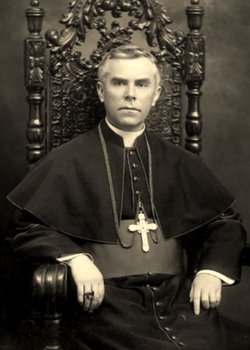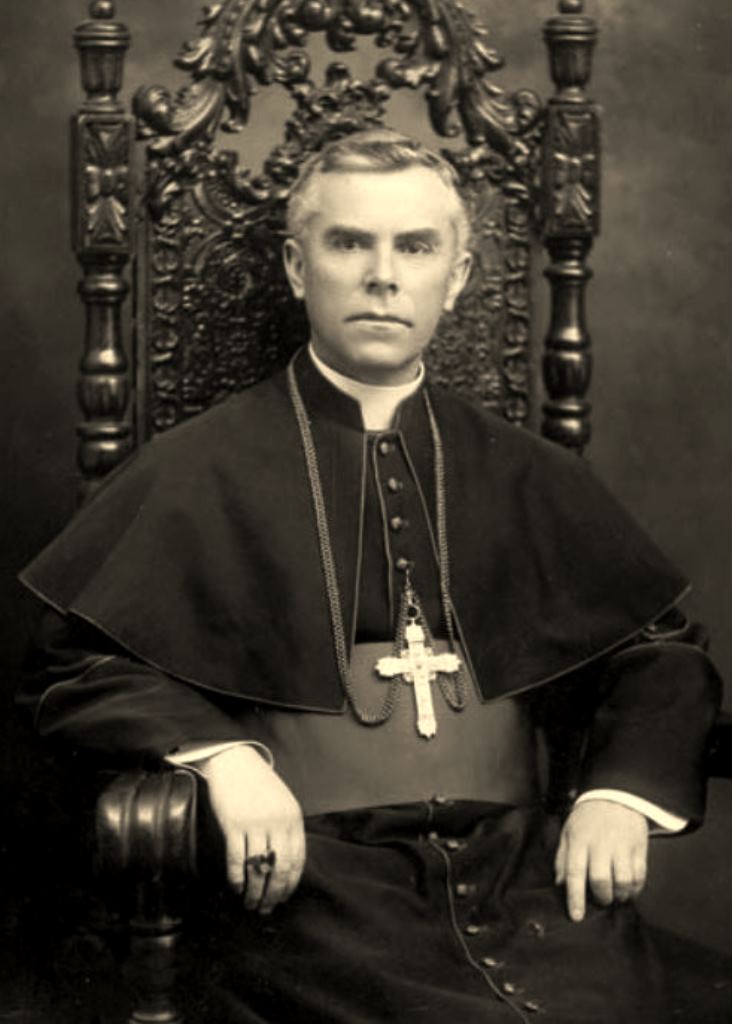(1st Bishop of Mont-Laurier)
26 Nov 1868 Born Saint-André-d'Argenteuil
23 Sep 1893 Ordained Priest
06 Aug 1913 Appointed Bishop of Mont-Laurier
28 Oct 1913 Ordained Bishop of Mont-Laurier
07 Jan 1922 Died Montréal
François-Xavier was born on November 27, 1868 and baptized two days later in the parish of Saint-André-d'Argenteuil, Québec. He was the son of François Brunet and Léocadie Joly.
In 1873, François-Xavier's parents settled in Ottawa, where his father worked as a carter. He received his elementary education from the Brothers of the Christian Schools and did his commercial and classical studies at the College of Ottawa, graduating with a Bachelor of Arts in 1890. He then decided to enter the priesthood and studied theology at the Grand Séminaire d'Ottawa. On September 23, 1893, at the age of 24, he was ordained by Archbishop Joseph-Thomas Duhamel of Ottawa. After serving as curate in Ottawa, as well as in Masson (Masson-Angers), Thurso, and Aylmer in Québec, Brunet became curé in Mayo, near Buckingham, Québec, in 1895. There he built the parish church for the Irish families and had a chapel erected for the German families.
Appointed parish priest of Bourget, Ontario, in 1900, he was called four years later to serve as secretary to Archbishop Duhamel, and then to his successor, Charles Hugh Gauthier.
On August 6, 1913, Fr Brunet was chosen bishop of the new diocese of Mont-Laurier, created through the subdivision of the diocese of Ottawa that April. In 1879, after a decade of expeditions to the northern part of his parish, the curé François-Xavier-Antoine Labelle of Saint-Jérôme had put forward the idea of subdividing the dioceses of Montreal and Ottawa to create a new one in the north. He saw his work of agricultural colonization as the essential bulwark against the Protestants in the county of Argenteuil, who wanted to occupy the same territory. After the bishop of Montreal had refused to split his diocese, Labelle had left it to the religious authorities in Ottawa, who had piloted the project until 1913, changing the location of the proposed bishop's palace, however, from Nominingue to Mont-Laurier. Brunet was thoroughly familiar with the strengths and weaknesses of the territory being entrusted to him, with its farmland and forests. As secretary to the bishops of Ottawa, he had accompanied them on their pastoral visits to every parish in the vast diocese and had been put in charge in 1912 of an inquiry into the advantages and disadvantages of erecting a diocese with a seat in Mont-Laurier.
In January 1921, Rome authorized Bishop Brunet to set up the community of Sœurs de Notre-Dame de Mont-Laurier, so that the need for teachers in the parish schools of his diocese could be met. A month later he was one of the bishops who pressed for the founding of the Séminaire des Missions Étrangères, which was erected in Pont-Viau in 1924. Priests would go out from this seminary to work in many parts of the world. On returning in December 1921 from a journey to St Boniface (Winnipeg), Manitoba, to attend the consecration of Bishop Joseph-Henri Prud'homme, Brunet had to take to his bed. A few days later he was transported to the Hôtel-Dieu in Montréal, where he died on January 7, 1922 at the age of 53. After the funeral service, his remains were placed in the crypt of his cathedral in Mont-Laurier.
During his short, eight-year episcopate, François-Xavier Brunet was able to set his diocese on a firm foundation. He was a builder who erected 12 new parishes, founded the Séminaire Saint-Joseph, and constructed the episcopal residence and the cathedral. He had a keen sense of observation, sound judgement, and great facility with words. Through his knowledge of the human condition, he was able to choose remarkable colleagues to lay the cornerstones of his diocese.
(1st Bishop of Mont-Laurier)
26 Nov 1868 Born Saint-André-d'Argenteuil
23 Sep 1893 Ordained Priest
06 Aug 1913 Appointed Bishop of Mont-Laurier
28 Oct 1913 Ordained Bishop of Mont-Laurier
07 Jan 1922 Died Montréal
François-Xavier was born on November 27, 1868 and baptized two days later in the parish of Saint-André-d'Argenteuil, Québec. He was the son of François Brunet and Léocadie Joly.
In 1873, François-Xavier's parents settled in Ottawa, where his father worked as a carter. He received his elementary education from the Brothers of the Christian Schools and did his commercial and classical studies at the College of Ottawa, graduating with a Bachelor of Arts in 1890. He then decided to enter the priesthood and studied theology at the Grand Séminaire d'Ottawa. On September 23, 1893, at the age of 24, he was ordained by Archbishop Joseph-Thomas Duhamel of Ottawa. After serving as curate in Ottawa, as well as in Masson (Masson-Angers), Thurso, and Aylmer in Québec, Brunet became curé in Mayo, near Buckingham, Québec, in 1895. There he built the parish church for the Irish families and had a chapel erected for the German families.
Appointed parish priest of Bourget, Ontario, in 1900, he was called four years later to serve as secretary to Archbishop Duhamel, and then to his successor, Charles Hugh Gauthier.
On August 6, 1913, Fr Brunet was chosen bishop of the new diocese of Mont-Laurier, created through the subdivision of the diocese of Ottawa that April. In 1879, after a decade of expeditions to the northern part of his parish, the curé François-Xavier-Antoine Labelle of Saint-Jérôme had put forward the idea of subdividing the dioceses of Montreal and Ottawa to create a new one in the north. He saw his work of agricultural colonization as the essential bulwark against the Protestants in the county of Argenteuil, who wanted to occupy the same territory. After the bishop of Montreal had refused to split his diocese, Labelle had left it to the religious authorities in Ottawa, who had piloted the project until 1913, changing the location of the proposed bishop's palace, however, from Nominingue to Mont-Laurier. Brunet was thoroughly familiar with the strengths and weaknesses of the territory being entrusted to him, with its farmland and forests. As secretary to the bishops of Ottawa, he had accompanied them on their pastoral visits to every parish in the vast diocese and had been put in charge in 1912 of an inquiry into the advantages and disadvantages of erecting a diocese with a seat in Mont-Laurier.
In January 1921, Rome authorized Bishop Brunet to set up the community of Sœurs de Notre-Dame de Mont-Laurier, so that the need for teachers in the parish schools of his diocese could be met. A month later he was one of the bishops who pressed for the founding of the Séminaire des Missions Étrangères, which was erected in Pont-Viau in 1924. Priests would go out from this seminary to work in many parts of the world. On returning in December 1921 from a journey to St Boniface (Winnipeg), Manitoba, to attend the consecration of Bishop Joseph-Henri Prud'homme, Brunet had to take to his bed. A few days later he was transported to the Hôtel-Dieu in Montréal, where he died on January 7, 1922 at the age of 53. After the funeral service, his remains were placed in the crypt of his cathedral in Mont-Laurier.
During his short, eight-year episcopate, François-Xavier Brunet was able to set his diocese on a firm foundation. He was a builder who erected 12 new parishes, founded the Séminaire Saint-Joseph, and constructed the episcopal residence and the cathedral. He had a keen sense of observation, sound judgement, and great facility with words. Through his knowledge of the human condition, he was able to choose remarkable colleagues to lay the cornerstones of his diocese.
Sponsored by Ancestry
Advertisement
Advertisement



